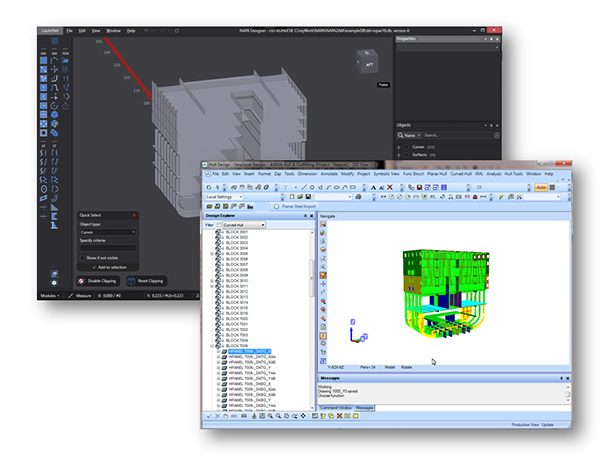
|
|
The end-to-end use of digital information in the shipbuilding industry demands the integration of a large number of different systems, which are used for different tasks and domains. PROSTEP offers a standards-based integration platform for this purpose that facilitates fast connection of all the relevant IT systems. In the future, it will also support the exchange of data between NAPA Steel and AVEVA Marine Hull. 
NAPA is the world's leading provider of tools for designing ships. This includes NAPA Steel, a software solution which is used in the early design phase for the fast and flexible creation and modification of the hull structure. However most shipyards use software from AVEVA Marine for the subsequent detailed design of the steel structures and outfit components. Although both are so-called intent-driven systems, which store almost no explicit geometry but instead record the way in which it was created and its relationships to other structural elements, the data from NAPA Steel cannot be used "as is" in AVEVA Marine. In practice, the ship designers have to reconstruct the steel structures. Shipyards are extremely interested in improving integration of the two systems so that they can use the tool best suited for each task without having to regenerate the hulls again and again. Earlier attempts at integrating NAPA Steel in the systems used for the detailed design phase were unsuccessful, which is why all the parties involved were skeptical as to whether the integration experts from PROSTEP would succeed. And succeed they did: At this year's NAPA User Conference in Helsinki in early June, they presented a proof of concept (POC) for an integration solution that impressed both NAPA and potential customers. As a result, the Finnish software vendor officially commissioned us to develop a NAPA Steel / AVEVA Marine Hull interface. The development project is being sponsored by the Korean shipyard Hyundai Heavy Industries. The biggest challenge to be mastered when it comes to developing the new interface is mapping the different data structures of the two systems to one another in such a way that the definition of the topology, parametric features such as holes, and final trimming can be transferred to the target system with the same level of quality as in the source system and reconstructed there. What makes the import strategy that PROSTEP has developed special is its high level of error tolerance. The interface is also capable of transferring topology information that is not actually transferable in such a way that allows at least the geometry to be generated. Users do not have to read long error reports in order to see which structural elements in the target system have which level of quality as this is indicated by the use of different colors in the user interface. The new interface is still in the process of being developed and the aim for the next stage is that it support the transfer of up to 80 percent of the components. The solution has already been presented to other interested shipyards in parallel to development in order to gather feedback and ensure that the right priorities are set during development. The development work is being coordinated by the software vendor NAPA, which expects elimination of the media break in the process chain between the early design phase and the basic design phase to lead to wider use of NAPA Steel. |
|
| © PROSTEP AG | ALL RIGHTS RESERVED | IMPRESSUM | DATENSCHUTZERKLÄRUNG | HIER KÖNNEN SIE DEN NEWSLETTER ABBESTELLEN. |

